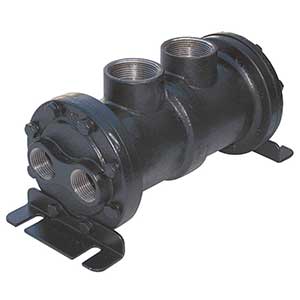An oil cooler is a heat exchanger designed to cool engine oil, transmission oil, or hydraulic oil to maintain optimal operating temperatures. The materials used in oil coolers must withstand high temperatures, pressure, and corrosion while ensuring efficient heat transfer. Here are the common materials used:
1. Core Materials (Heat Transfer Components)
Aluminum (Most Common)
Lightweight, corrosion-resistant, and offers good thermal conductivity.
Used in tube-and-fin or plate-and-bar oil coolers.
Often anodized or coated for extra durability.
Copper/Brass (Less Common)
Excellent thermal conductivity but heavier than aluminum.
Used in some heavy-duty or older oil coolers.
More prone to corrosion in harsh environments unless coated.
Stainless Steel (For High-Pressure/Corrosive Environments)
Used in heavy-duty or industrial applications.
Resistant to rust and chemical degradation.
2. Housing/End Tanks
Aluminum (Common) – Lightweight and corrosion-resistant.
Plastic/Nylon (In Some OEM Designs) – Used in cost-effective designs but less durable.
Steel/Stainless Steel (For Heavy-Duty Applications) – More robust but heavier.
3. Seals & Gaskets
Nitrile (NBR) Rubber – Resistant to oil and heat.
Viton (FKM) Rubber – Higher temperature and chemical resistance than nitrile.
Silicone – Used in some high-temperature applications.
4. Fins (For Air-Cooled Oil Coolers)
Aluminum Fins – Lightweight and improves heat dissipation.
Copper Fins – Rare due to weight and cost but excellent heat transfer.
5. Coolant Lines (For Oil-to-Water Coolers)
Aluminum or Stainless Steel Tubes – For durability and heat transfer.
Reinforced Rubber or Silicone Hoses – For flexible connections.
Types of Oil Coolers & Material Variations
Air-Cooled Oil Coolers (Common in performance cars) – Use aluminum cores with fins.
Water-Cooled (Oil-to-Water) Coolers – Use aluminum or stainless steel for better heat exchange with coolant.
Stacked Plate vs. Tube-and-Fin Designs – Aluminum is dominant in both, but plate designs may have better durability.
Why Material Choice Matters
Aluminum is favored for its balance of weight, cost, and heat transfer.
Stainless Steel is used where corrosion resistance is critical.
Copper/Brass is less common due to weight but offers superior heat transfer. Would you like recommendations for a specific application (e.g., automotive, industrial, racing)?
